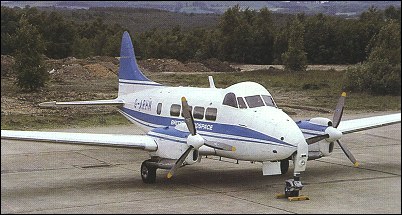 |
De Havilland D.H.104 Dove / Devon1945 |  |
| LIGHT TRANSPORT | Virtual Aircraft Museum / United Kingdom / De Havilland |
 |
To provide a post-war replacement for the D.H.89 Dragon Rapide biplane transport, which had also seen extensive service with the Royal Air Force and Royal Navy as the Dominie, the de Havilland design team under R. E. Bishop's leadership in 1944 evolved a new low-wing monoplane which, with the exception of fabric-covered elevators and rudder, was of all-metal construction. Powerplant consisted of two de Havilland Gipsy Queen engines, and their constant- speed fully-feathering and reversible- pitch propellers made the de Havilland D.H.104 Dove the first British transport aircraft to use reversible-pitch propellers for braking assistance. Standard accommodation as a transport was for 8 to 11 passengers. First flown on 25 September 1945, the prototype soon demonstrated that there was little wrong with the basic design. Apart from the addition of a dorsal fin at an early stage of development to improve stability with one engine out, much later of a redesigned elevator, and of a domed roof to give a little more headroom on the flight deck, production aircraft were generally similar to the original prototype. The Dove production variants resulted from differing Gipsy Queen powerplants, these including the 246kW Gipsy Queens 71 and 70-3 powering the prototype and the Dove 1/2 respectively; 254kW Gipsy Queen 70-4 in the Dove 1B/2B; 283kW Gipsy Queen 70-2 in the Dove 5/6, and 298kW Gipsy Queen 70-3 in the Dove 7/8. A number of Dove conversions carried out subsequently by Riley Aircraft in the USA as the Riley Turbo Executive 400 introduced 298kW Avco Lycoming IO-72- A1A flat-eight piston engines. A more ambitious conversion by Carstedt Inc. at Long Beach, California introduced two 451kW Garrett AirResearch TPE3.31 turboprop engines and a lengthened fuselage to accommodate 18 commuter passengers. Named Carstedt Jet Liner 600, the type was supplied primarily to Apache Airlines. Like the Rapide, which it superseded and supplemented (replaced is an unsuitable word, for Rapides just went on flying), the Dove proved to be reliable and popular, and 542 were built before production ended in 1968. Of these just over 100 were supplied under the name Devon to many air forces, including the RAF, and a small number went to the Royal Navy with the name Sea Devon. In addition to the light transport role for which they were intended, many have served as business, executive, and VIP aircraft.
|  COMPANY PROFILE | ||||||||||||||||||||||||||||||||||||||||||||||||||||||||||
 |

|



Hi Larry,
I'm only 11 years late replying, but you expressed an interest in a model of a DH114 Heron - which I have. I crashed it around the time of your note on Aviastar and have only just got round to repairing it, converting it to a series 2 machine G-AOTI, the full size of which is at the DeHav museum at London Colney. My model is 12 foot span, electric powered and weighing only 20 pounds flies at scale speed.
reply